
ver.200603E
SHOWA DENKO K.K. (https://www.shodex.com/)
1
Operation Manual
Shodex
IC SI-36 4D
(Please read this manual carefully to achieve the best and consistent column performance for a long time)
Important Handling Instructions
Caution! · Please consult the Safety Data Sheet (SDS) of reagents and solvents used with the column
and understand their proper handling methods to prevent potential health hazards or death
from occurring.
·
Please wear appropriate personal protective equipment such as lab goggles and gloves
when handling organic solvents and acid and alkaline reagents. Avoid any direct physical
contact to prevent chemical injuries.
Before Using the Column
(1) Please visually inspect the package and outside of the column for any damage.
(2) Please check if product name and serial number written on the column package, adhesive label, and
enclosed Certificate of Analysis (CoA) are matching and correct.
1. Introduction
Thank you for purchasing the Shodex product. Shodex IC SI-36 4D is a suppressor type ion
chromatography column for analysis of anions. The column is used with hydroxide eluents such as
potassium hydroxide and sodium hydroxide. The column is suitable for the separations of standard anions
including fluoride, chloride, nitrite, bromide, nitrate, sulfate, and phosphate, as well as sulfite.
2. Column Components
3. Column Specifications
Product
Code Product Name Column Size (mm) Particle Size (μm)
Theoretical Plate
Number
(Per Column)
I.D. Length
F6999361 IC SI-36 4D 4.0 150 3.5 ≥ 8,500
F6709620 IC SI-90G 4.6 10 9 (Guard Column)
Base Material : Spherical porous particles of polyvinyl alcohol modified with quaternary ammonium group
Column Housing : PEEK
Screw Type : Internally-threaded type No.10-32 UNF
Shipping Solvent : 10 mM Sodium Sulfate Solution (SI-36 4D)
: 1.8 mM Sodium Carbonate Solution + 1.7 mM Sodium Bicarbonate Solution (SI-90G)

ver.200603E
SHOWA DENKO K.K. (https://www.shodex.com/)
2
4. Usable Conditions
Usable solvents are listed below.
(1) In general, either potassium hydroxide or sodium hydroxide is used.
(2) The standard eluent is 25-mM potassium hydroxide. The higher the concentration of potassium hydroxide,
the faster the elution of ions will be.
(3) Up to 100 % acetonitrile is usable.
Attention! · Use the column within above stated flow rate, pressure, and temperature ranges. Using
the column outside the given range may damage the column and lower its performance.
· Column pressure is influenced by the eluent composition, flow rate, and column
temperature. When changing the eluent compositions, adjust the flow rate and column
temperature so that the column pressure remains below the usable maximum pressure.
5. Sample Preparation
(1) If possible, use the eluent for analysis to dissolve or dilute samples. If this is difficult, use a solvent which
has a composition that is as close as possible to the eluent's composition, but which fully dissolves or dilutes
the sample. When gradient elution is used, it is recommended to use the initial eluent to prepare the sample.
(2) Filter the sample solution using disposable 0.45-μm filter to prevent the column from clogging or deteriorating.
(3) Recommended sample injection volume is less than 10 - 25 μL per column.
When analyzing low concentration samples ( 0.1 mg/L), increasing the injection volume to 100 - 200 μL
may improve the detection.
(4) For the samples containing proteins, remove the proteins prior to the sample injection. The use of an
ultrafiltration membrane is recommended.
(5) For the samples containing hydrophobic impurities, remove the impurities prior to the sample injection. The
use of a solid phase extraction is recommended.
Note · Use of guard column is recommended to protect the analytical column.
6. Column Usage Procedure
6.1 HPLC System Preparation
Wash entire LC system prior to the column installation, including all flow-lines and sample loop by switching the
valve, and then replace the washing solution with the eluent to be used. If desired new eluent has low
miscibility/solubility to the eluent of previous analysis, first use the eluent that is miscible/soluble to both eluents,
and then replace it with the desired eluent.
e.g. When replacing chloroform to water, first run methanol and then replace it with water.
Attention! · If the eluent left in the system is not compatible with the column to be used, it may damage
the column.
· A drastic change in the eluent compositions may remove substances adsorbed on the
system and they may enter and deteriorate the column.
Product Name Flow Rate (mL/min) Maximum
Pressure (MPa)
(Per Column)
pH
Range
Temperature Range (°C)
Recommended Maximum Recommended Range
IC SI-36 4D 0.7 0.9 20 3 - 14 30 20 - 60
IC SI-90G - - -

ver.200603E
SHOWA DENKO K.K. (https://www.shodex.com/)
3
6.2 Column Installation
(1) Connect the column to LC system by following the “flow direction arrow” (➡) indicated on the adhesive label.
(2) Make sure to insert the tubing all the way to the end fitting and secure it with the male nut. It is important that
there is no extra space between the tubing and the column side of the end fitting. Presence of an extra space
will let the sample to spread out and may result in wide peaks.
(3) Set the initial flow rate at less than 0.35 mL/min and start the system. If using the column at an elevated
temperature, keep a low flow rate until the temperature of the column reaches to the set temperature, and
then gradually increase the flow rate to the desired.
(4) When using the column for the first time, before connecting the column outflow to a suppressor, wash the
column with the eluent at 0.35-mL/min flow rate for more than 30 minutes. This also applies to when reusing
a column with which the eluent was replaced with shipping solvent.
Caution! · Verify that there is no solvent leak. It may cause electronic leakage, rust, and/or chemical
injury.
Attention! · Make sure not to let air bubbles enter the column while installing the column. The air
bubbles may damage the column.
· When restarting the system after column installation or after holding the eluent flow, start
the system at less than 0.35 mL/min. A rapid increase in pressure can damage the column.
· If the column was used at an elevated temperature, lower the flow rate to less than 0.35
mL/min at the end of analysis. Then, turn off the column oven, and let the column
temperature return to room temperature before stopping the pump. If the pump was
stopped while the eluent inside the column was still hot, as the eluent temperature
decreases, its volume also decreases. This may result in creating an empty space in the
column and deteriorates the column.
6.3 Eluents
(1) Use freshly generated ultrapure water (18.2 MΩ-cm ) to prepare the eluent.
(2) The use of an eluent generation system is highly recommend for the preparation of potassium hydroxide or
sodium hydroxide solution. If an eluent generation system is not available, dilute a reagent-special grade
potassium hydroxide or sodium hydroxide solution with ultrapure water.
(3) Degas the eluent fully to prevent the formation of air bubbles.
(4) Presence of small debris or insoluble substances may result in deterioration of the column and/or they appear
as noise on the chromatograms. Filter the eluent with a 0.45-μm disposable filter to prevent the problems.
(5) Start the system at less than 0.35 mL/min when replacing the solvent.
Attention! · Use HPLC grade organic solvent whenever possible. Solvents left in an opened bottle for
a long time should not be used. The content may have been changed, absorbed moisture,
or has been contaminated.
· Always use freshly prepared solvents. Solvents stored for a long time may have changed
their compositions and may influence elution patterns and/or damage the column.
· If using a manually prepared eluent, keep the eluent in a solvent reservoir with a carbonate
trap cartridge.
Note · Use of on-line degasser is recommended.
· It is recommended to set the pump limiter to avoid exceeding the maximum pressure.

ver.200603E
SHOWA DENKO K.K. (https://www.shodex.com/)
4
6.4 Column Cleaning
Problems in peak shapes and elution time changes or elevated column pressure etc. are often caused by
insoluble or adsorbing components present in the eluent and reagents being deposited inside the column. These
problems may be resolved by cleaning the column.
If a guard column is used with the analytical column, first remove the guard column and check the performance
of the analytical column alone. If the problem is solved, most likely the cause is from the guard column. In this
case, clean the guard column.
If the problem is not solved by removing the guard column, clean both guard and analytical columns. Make sure
to clean the guard and the analytical columns separately. When washing the column, let the washing solution
flow from the column outlet go directly into the waste container and not let the solution go through the detector.
<Cleaning Method>
(1) Insoluble components that block the column inlet may be removed by reversing the flow direction, i.e.,
introducing the eluent from the column outlet, with flow rate at less than half of the recommended flow rate.
(2) Follow below cleaning steps for adsorbing components. For an efficient cleaning, reverse the flow direction
and use the flow rate at 0.35 mL/min
Method 1: Adsorption of hydrophilic compounds
Washing Solution Cleaning Time
1 H2O 25 min
2 100 mM KOH or NaOH aq. solution 100 min
3 H2O 25 min
4 Eluent 100 min
Method 2: Adsorption of hydrophobic compounds
Washing Solution Cleaning Time
1 H2O 25 min
2 H2O/CH3CN = 95/5 20 min
3 CH3CN 100 min
4 H2O 50 min
5 Eluent 100 min
7. Column Storage
If preferred to store the column with the eluent used, remove the column from the system, securely tighten the
end caps and store the column in a refrigerator. Alternatively, if preferred to store the column at a room
temperature, replace the in-column solvent with the shipping solvent. Then, remove the column from the system,
securely tighten the end caps and store the column at a location with stable temperature (a cool and dark space
is recommended). Refer to section 6.3 Eluents for how to replace the eluent.
Attention! · Never allow inside of the column to dry. It can damage the column.
· When replacing the in-column solvent with shipping solvent, detach the suppressor before
introducing the shipping solvent to the column.
· When reusing the column stored in a refrigerator, first wait for the column temperature to
be ambient, and then remove the end caps and install the column on the system.

ver.200603E
SHOWA DENKO K.K. (https://www.shodex.com/)
5
8. Column Inspection
Inspection method is described in the Certificate of Analysis (CoA).
Theoretical Plate Number (N) and Asymmetry Factor (Fas) were calculated using the below equations.
(1) Theoretical Plate Number (N)
(2) Asymmetry Factor (Fas)
9. Additional Warnings
(1) Do not remove end fittings.
(2) Do not make a strong impact on the column. Do not drop or hit the column on a hard surface.
Refer to the Shodex™ website (https://www.shodex.com/) for product details and their applications.
For additional assistance, contact the distributor from whom you purchased the column or contact your regional
Shodex support office (https://www.shodex.com/en/support_office/list/).

ver.200603E
SHOWA DENKO K.K. (https://www.shodex.com/)
6
10. Warranty (Ver. 4COLUMN)
(1) Showa Denko K. K. warrants that the Shodex product, at the time of delivery to the user, will conform to
the specification of the attached CERTIFICATE OF ANALYSIS, if the Shodex product is used in accordance
with the attached operating manual. The foregoing warranty is exclusive and is in lieu of all other warranties
with respect to the Shodex product, whether written, oral, implied, statutory or otherwise. No warranties by
Showa Denko K. K. are implied or otherwise created, including, but not limited to, the warranty of merchantability
and fitness for particular purposes.
(2) Any claim of inconformity to the specification must be notified to Showa Denko K.K. within ten (10) days after
delivery to the user. User’s exclusive remedy and Showa Denko K.K.‘s exclusive liability for such claim are
limited to the replacement of the Shodex product in question. In no event is Showa Denko K.K. liable for any
indirect, incidental or consequential damage arising out of in connection with the Shodex product, whether or
not such damage is allegedly based on breach of warranty, negligence or otherwise.
(3) No warranty is made in any of the following cases:
3-1 If the Shodex product is not used in accordance with the operating manual
3-2 If the Shodex product is remodeled by anyone other than person or firm designated by Showa Denko K.K.
3-3 If the Shodex product is disposed of
3-4 If the Shodex product is resold by the user without giving prior written notice to Showa Denko K.K.
3-5 If the performance of the Shodex product is not conform to the specification of the attached CERTIFICATE
OF ANALYSIS due to any of the reasons below:
a. Computer virus
b. Impurities contained in the sample, reagent, gas air or cooling water provided by the user
c. Breakdown or malfunction of equipment, apparatus or component used in combination with the Shodex
product
d. Force majeure such as fire, earthquake, flood, other natural disaster, crime, riot, act of terrorism, war or
radioactive contamination
(4) In no event is Showa Denko K.K. liable for
4-1 the results of analysis or preparations using the Shodex product or any portion of the same, including, but
not limited to, the reliability, accuracy, efficacy and safety of said results, and
4-2 the occupational hazard in the use of the Shodex product, whether or not such use is made in accordance
with the attached Conditions for use.
(5) The Shodex product is for laboratory use only. It must not be used for clinical diagnosis. Showa Denko K.K.
is not liable for any use of the Shodex product except laboratory use.
Following names are trademarks or registered trademarks of SHOWA DENKO K.K.
Shodex, AFpak, Asahipak, AXpak, CLNpak, CXpak, HILICpak, MSpak, ODP, OHpak,
ORpak, RSpak, SUGAR, USPpak.
Products described in the operation manual are not intended for medical use or medical applications.
-
 1
1
-
 2
2
-
 3
3
-
 4
4
-
 5
5
-
 6
6
Shodex IC SI-36 4D Operating instructions
- Type
- Operating instructions
- This manual is also suitable for
Ask a question and I''ll find the answer in the document
Finding information in a document is now easier with AI
Related papers
-
Shodex NH2P-40 3E Operating instructions
-
Shodex SI-90 4E Operating instructions
-
Shodex VG-50 4D and 4E Operating instructions
-
Shodex NH2P-50 2D Operating instructions
-
Shodex NH2P 10E Prep Column Operating instructions
-
Shodex VN-50 10E Prep Column Operating instructions
-
Shodex SI-35 2B Operating instructions
-
Shodex SI-52 4E Operating instructions
-
Shodex DS-613 Operating instructions
-
Shodex VT-50 2D Operating instructions
Other documents
-
 Thermo Fisher Scientific Aquion Quick start guide
Thermo Fisher Scientific Aquion Quick start guide
-
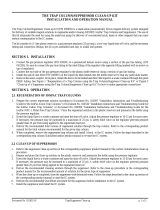 Thermo Fisher Scientific Trap Column/Suppressor Clean-Up Kit Owner's manual
Thermo Fisher Scientific Trap Column/Suppressor Clean-Up Kit Owner's manual
-
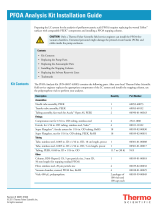 Thermo Fisher Scientific PFOA Analysis Kit Installation guide
Thermo Fisher Scientific PFOA Analysis Kit Installation guide
-
 Thermo Fisher Scientific Dionex CarboPac PA1 Column User manual
Thermo Fisher Scientific Dionex CarboPac PA1 Column User manual
-
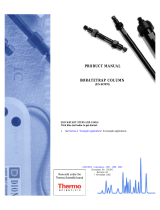 Thermo Fisher Scientific BorateTrap Column User manual
Thermo Fisher Scientific BorateTrap Column User manual
-
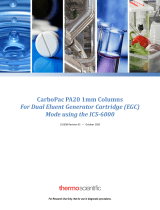 Thermo Fisher Scientific CarboPac PA20 1mm Columns For Dual Eluent Generator Cartridge Owner's manual
Thermo Fisher Scientific CarboPac PA20 1mm Columns For Dual Eluent Generator Cartridge Owner's manual
-
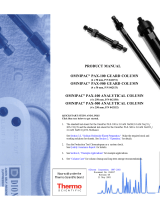 Thermo Fisher Scientific OmniPac PAX-100 and PAX-500 Columns User manual
Thermo Fisher Scientific OmniPac PAX-100 and PAX-500 Columns User manual
-
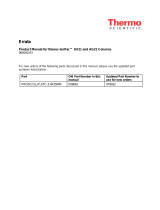 Thermo Fisher Scientific IonPac AS21 and AG21 Columns User manual
Thermo Fisher Scientific IonPac AS21 and AG21 Columns User manual
-
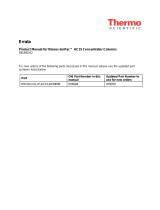 Thermo Fisher Scientific IonPac AC15 Concentrator Column User manual
Thermo Fisher Scientific IonPac AC15 Concentrator Column User manual
-
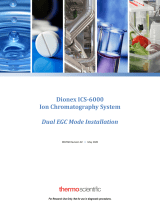 Thermo Fisher Scientific Dionex ICS-6000 Ion Chromatography System Installation guide
Thermo Fisher Scientific Dionex ICS-6000 Ion Chromatography System Installation guide















